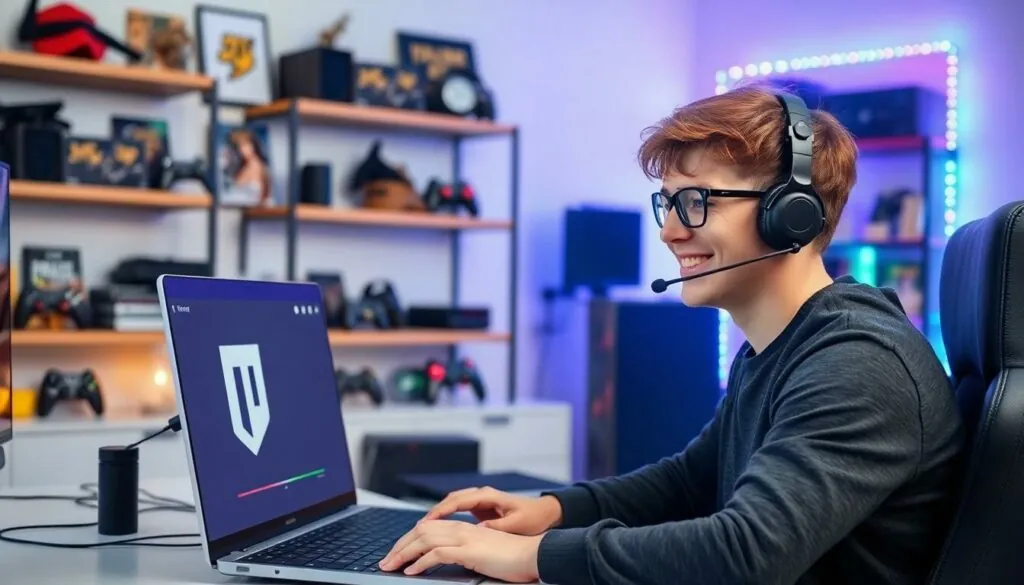Ready to unleash your inner gaming guru and hit that “Go Live” button on Twitch? It’s about time! Streaming on Twitch from a laptop is easier than finding a cat video on the internet, and it can turn your gaming passion into a captivating show that keeps viewers glued to their screens.
Table of Contents
ToggleUnderstanding Twitch Streaming
Twitch serves as a popular live-streaming platform for gamers and content creators. Streaming games, creative content, and real-life activities attracts diverse audiences, making it a dynamic space for interaction.
What is Twitch?
Twitch is a live streaming platform primarily focused on video game streaming. Users can broadcast gameplay, connect with viewers through chat, and gain followers. Utilizing features like emotes and subscriptions, Twitch fosters community engagement. Mobile devices and consoles also offer access, expanding its reach beyond just laptops.
Benefits of Streaming on Twitch
Streaming on Twitch brings various benefits for content creators. First, it provides an opportunity to monetize content via subscriptions and donations. Engaging with audiences enhances connection, allowing for real-time interaction. Building a personal brand becomes attainable as streamers grow their presence. Exposure to a larger audience can lead to potential partnerships and sponsorships. Networking with other creators enriches the streaming experience and promotes collaboration.
Preparing Your Laptop for Streaming

Setting up a laptop for Twitch streaming requires specific technical considerations. Focus on meeting system requirements and installing recommended software for effective streaming.
Minimum System Requirements
Laptops must meet certain specifications for smooth streaming. A compatible processor, such as an Intel Core i5 or AMD Ryzen 5, is essential. RAM must be at least 8 GB to handle streaming and gameplay simultaneously. Graphics capability requires a dedicated GPU, specifically NVIDIA GeForce GTX 600 series or AMD Radeon HD 7000 series or better. A stable internet connection with a minimum upload speed of 3 Mbps ensures reliable streaming quality. Windows 10 or the latest version of macOS is necessary for optimal performance.
Recommended Software for Streaming
Software selection is crucial for successful streaming. OBS Studio stands out as a top choice due to its free nature and extensive customization options. Streamlabs OBS enhances user experience with added features like built-in alerts and overlays. XSplit offers a user-friendly interface, but it comes with subscription costs. Choosing software also requires consideration of user needs and preferences, as some may prioritize ease of use while others might seek advanced features. Whichever software selected, regular updates help maintain stability and performance.
Setting Up Your Twitch Account
Setting up a Twitch account is essential for streaming. This step requires straightforward actions to get started.
Creating a Twitch Account
To create a Twitch account, visit the official Twitch website. Click on the ‘Sign Up’ button located at the top right corner of the homepage. Input the required information, including a unique username, password, date of birth, and email address. After entering these details, confirm your email to activate your account. Twitch also allows for sign-ups using existing Amazon or Facebook accounts, expediting the process.
Configuring Your Profile
Configuring a Twitch profile enhances viewer engagement. Access your account settings by clicking on your username and selecting ‘Dashboard.’ Here, users can upload a profile picture, add a bio, and set up social media links. Emphasizing interests, favorite games, and streaming schedules attracts viewers. Adjust privacy settings to manage chat and notifications. Regularly updating profile details keeps the presence fresh, encouraging audience interaction.
How to Go Live on Twitch on Laptop
Streaming on Twitch from a laptop involves several steps. He or she can start broadcasting by following a few straightforward guidelines.
Downloading Streaming Software
First, select a streaming software that suits specific needs. OBS Studio is highly recommended for its customization features, while Streamlabs OBS offers excellent enhancements for beginners. Installing XSplit is another option, though it requires a subscription. Navigate to the respective website and download the application compatible with the operating system. Follow the installation prompts, ensuring that any necessary permissions are granted for full functionality.
Setting Up Streaming Software
Open the installed streaming software to begin setting it up. Configure the software by selecting the correct input and output settings, including resolution and bit rate. Optimize the settings for performance based on the laptop’s specifications. In the software, he or she can add sources, such as game capture or webcam video. Customize the layout with overlays, alerts, and scenes to enhance viewer engagement. Save the configuration preferences and test the setup to ensure everything appears as intended.
Connecting Your Twitch Account
Linking the streaming software to a Twitch account is crucial for going live. Locate the stream settings within the software and find the option to connect to Twitch. Log in using account credentials or paste the provided stream key directly into the settings. Verify the connection to ensure the software can transmit the stream. Finally, enable the option to automatically start the stream with this connection for seamless broadcasting.
Tips for a Successful Twitch Stream
Engaging with viewers enhances the streaming experience. Start by interacting through live chat, responding to comments, and encouraging questions. Incorporate polls or shoutouts during the stream to make viewers feel included. Using social media to announce live streams and post highlights expands outreach. Additionally, streamers should maintain a consistent schedule, letting followers know when to tune in. This predictability fosters loyalty and strengthens community ties.
Improving stream quality ensures a professional appearance. Begin with a reliable internet connection, targeting an upload speed of at least 5 Mbps. Adjusting resolution settings between 720p and 1080p creates a balance between quality and performance. Streamers benefit from using high-quality microphones to enhance audio clarity, as poor sound quality can deter viewers. Regularly checking hardware specifications helps maintain optimal performance. Lastly, utilizing overlays and alerts can elevate the visual appeal, making the stream more engaging for viewers.
Going live on Twitch from a laptop opens up a world of possibilities for gamers and content creators. With a few simple steps and the right tools, anyone can share their gaming experiences and connect with an audience. By focusing on quality and engagement, streamers can build a loyal community and explore monetization opportunities.
Embracing the streaming journey not only enhances personal gaming skills but also fosters connections with like-minded individuals. As technology continues to evolve, the potential for growth on platforms like Twitch remains vast. With dedication and creativity, it’s possible to transform a passion for gaming into a rewarding streaming career.




